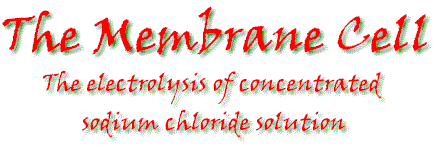
|
|
|
The electrolysis of purified, concentrated sodium chloride solution has been used for a long time to manufacture sodium hydroxide, chlorine and hydrogen. The Membrane Cell is replacing the older techniques which used the Castner-Kellner cell (problems with mercury pollution) and the Gibbs Diaphragm cell (contamination of the NaOH produced with NaCl) because it gives a much purer solution of sodium hydroxide and the whole process is more energy-efficient and less polluting. The process’s success rests on the nature of the membrane. It is a modified PTFE called Naflion (a du Pont polymer), the structure being given below. Not one to be memorised!
The sulphonyl groups (- SO3H) make it a cation-exchange membrane, so it will pass cations but not anions between compartments of the cell. This has nothing to do with pore size; it depends only on the ions being positively charged. Thus sodium ions can pass to the cathode compartment, but chloride (or other anions) cannot and so cannot contaminate the NaOH product. Since any cations can pass through, it is important for the purity of the NaOH produced that the concentrated brine that is fed in be pure and free from metal ions other than sodium. Note that the solution must be concentrated - otherwise chlorine is not produced at the anode. The membrane is not semi-permeable – this should be used only to describe a membrane that passes a solvent from low to high concentration in osmosis. In the left-hand anode compartment of the cell (see below) chloride ions are oxidised to chlorine gas: 2Cl – ŕ Cl2 + 2e – or Cl – ŕ ˝ Cl2 + e – Sodium ions then pass across the membrane to the cathode compartment. There, the water molecules (or, if you prefer, hydrogen ions from the water) are reduced to hydrogen gas, leaving hydroxide ions: 2H2O + 2e – ŕ H2 + 2 OH – or 2H+ + 2e – ŕ H2 The anode compartment therefore contains sodium hydroxide solution. In one type of cell (not the only one) 33% NaOH is taken out near the top of the anode compartment; some of this solution is taken for concentration and sale, and some is diluted with water to 30% concentration and returned to the bottom of the anode compartment. A diagram of this cell is given below.
|
|
|
|
|
|
The membrane is much more than a physical barrier reducing diffusion or preventing mixing of the product gases; its ability to accept cations but reject anions is central to its functioning.
|